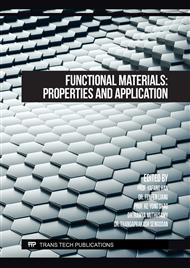p.137
p.143
p.155
p.163
p.169
p.177
p.185
p.195
p.203
Synthesis of Composite Carbon Fiber Electrode Materials for CO2 Reduction
Abstract:
For the purpose of environmental protection, the solution to the excessive release of carbon dioxide in the atmosphere has become the focus of current research. The electrochemical reduction of carbon dioxide, which enables the capture and storage of carbon dioxide and its conversion into new compounds, has shown its effectiveness. By studying various methods of preparing CO2 absorption electrodes, Carbon fiber material is considered as a promising electrode material due to its good electrical conductivity and availability. In this paper, Ag/PTFE composites (Silver as catalyst, PTFE as hydrophobic agent), combined with carbon fibers, are used as Gas diffusion electrodes (GDE) materials. After verifying its hydrophobicity by contact angle measurement, the performance of electrode is tested. The results show that the new electrodes synthesised are suitable for use as Gas diffusion electrodes materials (GDE) and that Ag catalysts combined with carbon nanofibers can be used for the electrochemical reduction of CO2.
Info:
Periodical:
Pages:
203-208
Citation:
Online since:
October 2022
Authors:
Price:
Сopyright:
© 2022 Trans Tech Publications Ltd. All Rights Reserved
Share:
Citation:


